The information – Ingrowing toenails
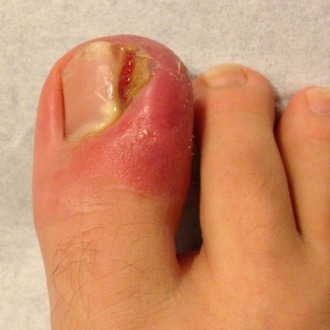
The patient’s unmet needs (PUNs)
A 19-year-old boy presents with his mum. Both are adamant that he needs some antibiotics and that ‘something must be done’ for his ingrowing toenails – the patient because it’s stopping all his sporting activity and mum because her son is constantly complaining about the pain, and insisting he’s unable to wear anything but trainers. Examination reveals bilateral infected ingrowing toenails accompanied by florid granulation tissue. ‘I don’t know why he’s got them, we were so careful with his shoes when he was little,’ says his mother. ‘We’ve tried all the usual advice – surely he needs an operation?’
The doctor’s educational needs (DENs)
What causes ingrowing toenails?
The following are some of the common causes of ingrowing toenails:
- Inherited – some people grow a very wide and rounded nail plate
- Poor nail care – picking toenails or poor cutting may leave sharp spikes
- Footwear – tight shoes may press on the side of the toenail
- Injury/infection – changes the growing area of the nail bed
- Medical problems – Diabetes, immunosuppressed, psoriasis or Raynaud’s
Sometimes problems begin when pressure from footwear distorts the growth of the nail, or the nail is either picked or trimmed into a curved shape. This allows one of its vertical edges to pierce the nail sulcus in which it lies.
What conservative measures are available, how effective are they and how long should they be tried for?
Advise the patient that good hygiene measures are important, not just for the toe but the feet in general. Daily soaking for no more than five minutes in warm salty water, topical antiseptic cream and a non-occlusive dressing can all be beneficial.
Open-toed footwear or socks around the house are advisable, as is avoiding tight shoes, heels etc.
If the feet are very sweaty, especially with teenagers, dally application of surgical spirit will act as an astringent. Silver nitrate will help to reduce granulation tissue, applied twice a week for 20 seconds, but this is sometimes painful.
If symptoms don’t resolve in two weeks you may consider a ring block to the toe with 2% lignocaine and removing the distal third of the nail – this works in around 50% of patients.
If an ingrowing toenail has previously occurred there is a probability it will keep on redeveloping, even with good patient care, so refer these at an early stage.
Old wives tales such as cutting a ‘v’ in the centre of the nail does not work, it just gives people something to do and keeps them away from the side of the nail. Silver foil being packed under the nail edge should also be avoided.
For ingrowing nails complicated by infection, are antibiotics necessary or will simple hygiene measures resolve the situation? Which is the antibiotic of choice?
If there is bleeding or discharge from an infection, or even excessive healing flesh (hypergranulation tissue) around the nail, antibiotics are indicated, with flucloxacillin being the normal antibiotic of choice unless other comorbidities exist. Take a swab for culture and sensitivity prior to antibiotics. If symptoms have not resolved after 10 days, refer to podiatry or remove the offending spike.
Patients with diabetes, the immunosuppressed and vascular-compromised patients should always be given appropriate antibiotic cover and referred to a specialist unit.
How effective is simple avulsion of the whole nail?
If the toe problem has been caused by picking or poor management, and there is no structural nail deformity, then removing all the nail plate may work as they can grow back to the original shape. But there is no structural problem in about one third of ingrowing toenails, so total removal of the nail plate has a high rate of recurrence (about 70%). In the 30% where nail plate removal does work, the nails could probably have been managed by routine podiatric care.
Be aware that there is the possibility that removing the nail plate totally can traumatise the nail bed and result in a very thick nail re-growing.
What are the definitive surgical options for this condition? How effective are they? Are they within the remit of most podiatrists or should these patients be referred to a surgeon?
Ingrowing toenail surgery is the normal remit of most podiatrists. Nearly all NHS podiatry departments run regular minor procedure clinics. The cost-benefits of this pathway compared to redirecting to general surgeons and admitting to hospital is a saving of more than 60% of tariff.
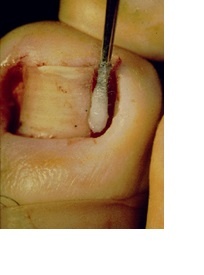
Image 1: The preferred simple phenolisation of the nail border
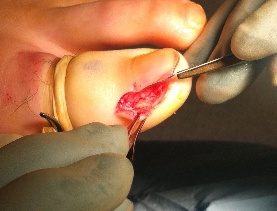
Image 2: Excisional nail and nail bed procedure
The simplest method for nail surgery is with phenolisation of the nail bed (see image 1), which is about 98% effective in experienced hands. This can be done in most minor treatment rooms. Other options are excisional procedures, which require full theatre facilities as the incisions go down to the distal phalanx (see image 2).
Phenolisation procedures take about 4-6 weeks to heal due to the chemical burn, although patients are usually fully active within 48 hours. Excisional procedures require sutures to be in situ for two weeks, and reduced mobility for one week post-op. These are usually more painful post-op and are reserved for when rapid healing is required with comorbidities, e.g. diabetes or compromised vascular situations.
If the nail has become ingrown several times, or the shape of the nail is so badly deformed that it is likely to re-grow, a decision may be made to remove part of the nail and nail bed. The end result will produce a normal-looking but slightly narrower nail. If the nail has become very deformed, or if removing side sections would achieve an unsatisfactory result, then the final option is to remove all the nail and nail bed. This is unusual and I would perform less than 1% of complete nail and nail bed removals.
Ingrown toenails may be categorised into groups based on severity, which will often determine their management.
Type 1 – ingrowing toenail

This ingrowing toenail often looks as though there is nothing wrong with it. It hurts in shoes, to touch and sometimes even bed clothes cause pain. This is often due to a slight curvature of the nail, tight shoes or poor cutting techniques. These often develop tiny corns in the nail sulcus and may be extremely painful. Simple trimming by a chiropodist or podiatrist will usually help to resolve this problem. If it is not treated it will often progress to a type 3 ingrowing toenail.
Type 2 – involuted ingrowing toenail
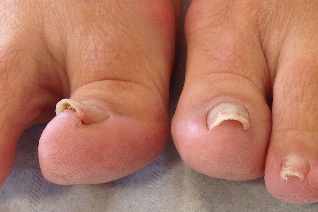
This problem is often seen in those over 50. The nail is excessively curved, sometimes following damage either from trauma or following fungal nail infections, and is frequently seen in psoriatic nails. Areas of corns and hard skin build up in the nail borders, causing pain, and these may become infected. If caught early, podiatry/chiropody treatment is the management of choice, otherwise it will often progress to type 3.
Type 3 – classic ingrowing toenail
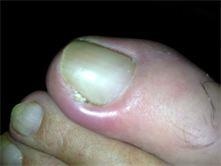
The most common is the infected and inflamed ingrowing toenail. The skin around the nail appears swollen, red and sometimes pus may be visible under the skin.
This is the classical ingrowing toenail, often found in teenagers or poor management of type 1 or 2. Frequently, this can be a one-off occurrence. Conservative management by a podiatrist, often without requiring a wedge resection, will frequently resolve the problem.
Type 4 – chronic infected ingrowing toenail with some granulation tissue
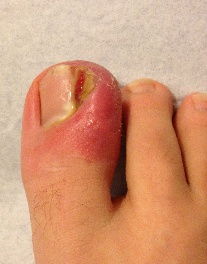
These nails have either not been treated adequately, or the nail has had repeated episodes of infection.
If the nail has become ingrown several times, or the shape of the nail is so badly deformed that it is likely to re-grow, a decision may be made to remove part of the nail root.
If the nail has become very deformed, the final option for type 4 ingrowing toenails is to remove the entire toenail.
Type 5 – chronic, both sides infected, with extensive granulation tissue
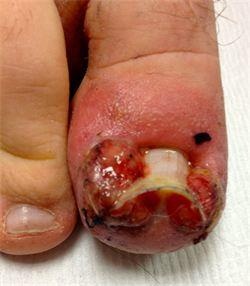
These nails are most frequently seen in young men who have either ignored the problem, or when repeated conservative treatment has failed.
They often cause little or no pain and it is the sight or smell that drives patients to seek further help.
Mr Michael O’Neil is a consultant in podiatric surgery at Barts Health NHS Trust, London, and at the Princess Margaret Hospital, Windsor.
Pulse October survey
Take our July 2025 survey to potentially win £1.000 worth of tokens

Visit Pulse Reference for details on 140 symptoms, including easily searchable symptoms and categories, offering you a free platform to check symptoms and receive potential diagnoses during consultations.










